 Apart from the famous TR
series, Triumph also built another hugely popular sports car in the
1960s and 70s. It was named after a British WWII warplane, Spitfire.
The Spitfire sat under the TR series to be an entry-level sports car.
Priced at merely £640 in the UK or $2200 in the US initially
(compared with £950 or $2660 of
an MGB), it was about the cheapest sports car people could buy then.
Only Austin-Healey Sprite and MG Midget competed in the same price
category, yet the Triumph had some premium features that its rivals
could not dream of, such as a beautiful Italian-styled body,
all-independent suspensions, front disc brakes, roll-up windows and the
availability of overdrive gearbox. No wonder the Spitfire was even more
popular than the TR. In its 18 years life, it sold 314,000 copies, plus
another 41,000 GT6s, its six-cylinder coupe version.
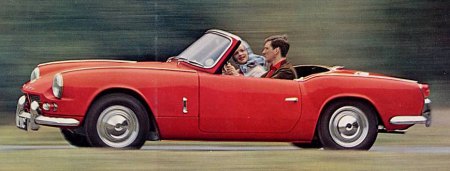 The original Spitfire was introduced in 1962. Like the
contemporary TR4, it was designed by famed Italian designer Giovanni
Michelotti. This was a proper roadster shape, being sleeker and
prettier than the TR4 and worth a comparison with the yet-born Fiat 850
Spider and 124 Spider. To make the low price possible, its
underpinnings were mostly taken from the Triumph Herald small saloon.
The latter's double-Y-shape backbone chassis was shortened and modified
to mate with a steel body shell which also acted as a stressed member
to reinforce the chassis. The Herald also donated its double-wishbones
front suspensions and swing-axle rear suspensions. The 1147 cc ohv
four-cylinder engine was tuned with hotter cams and twin-SU carburetors
to produce 63 hp. Coupling to a 4-speed gearbox this gave decent, if
not remarkable, performance. We are talking about 92 mph flat out and
0-60 in 17 seconds. For a car so cheap, what else could you expect?
After just 2 years, Triumph made some improvement to the Spitfire and created the Mk2. Its engine was tuned to 67 hp to give a bit more performance. The interior got improved trims and seats. The rest remained unchanged. Mk3 in 1967 got another power boost. This time it adopted the 1296 cc engine from Triumph 1300, lifting output to 75 hp. Besides, the braking was strengthened and the troublesome build-it-yourself soft roof was replaced with a proper manually lifted and clamped roof. Meanwhile, the Mk3 also got a facelift, which had the higher-mounted front bumper integrated with the nose in style. 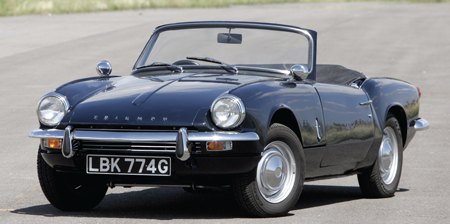 The Spitfire was always praised for good looks and practicality. Its cabin was practical to use and quite roomy for its class. Its optional overdrive ratios allowed good refinement for motorway cruising and outstanding fuel economy. The gearchange was precise and the clutch was smooth to operate. The brake pedal was heavy but the Girling front discs provided good stopping power. The steering was light and precise. The ride was busy but no worse than any small cars. However, its swing-axle suspension made the car difficult to handle when it was hurried through twisty roads. During cornering, body roll, bumps and lift-off throttle could easily induce dramatic oversteer and spin the rear wheels. Even though a lot of negative camber had been built to the rear suspension already, the problem was still unresolved. The Mk4 of 1970 got another Michelotti facelift, which looked cleaner and prettier than ever (this look would continue to the end). But most important was that the rear suspension finally got sorted. It retained the swing axles and upper transverse leaf springs, but the revised clamping method of bolting the lower spring to the differential, leaving the upper leaf springs free to move laterally, made a great improvement to the rear wheel camber control. This effectively tamed its handling, which was now described by Autocar as "extremely good". Unfortunately, the launch of Mk4 coincided with new emission regulations, which dropped its power to 63 hp thus performance suffered a setback. 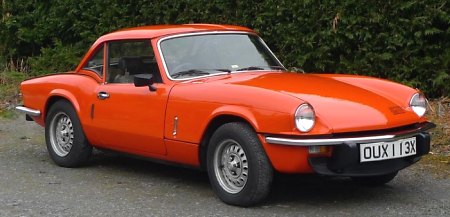 The last evolution, called 1500 instead of Mk5, was introduced in 1974. It restored the lost performance by adopting a long-stroke 1.5-liter engine with 73 hp and a whole lot more torque, although this came at the price of high-rev refinement. In this form, the Spitfire would soldier on until its retirement in 1980. When it left the world, its sales remained quite strong. Sadly, British Leyland decided to quit sports car making altogether and concentrate resources to mass production cars. The platform and components donor of Spitfire had died long ago thus it no longer made business sense to continue updating the sports car to meet future emission and safety regulations. Consequently, the last true Triumph came to the end. 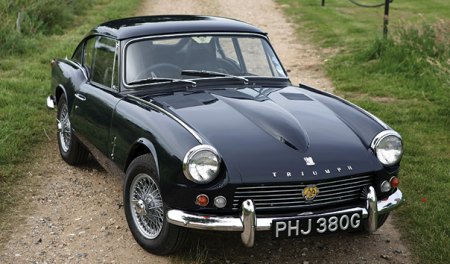 The GT6 was often seen as a "poor man's Jaguar E-Type", thanks to its similar appearance and straight-six power. Introduced in 1966, the GT6 was actually the six-cylinder coupe version of the Spitfire. It employed much the same chassis and suspension, but instead of the four-pot engine, a 2.0-liter ohv straight-six (from Triumph 2000 saloon) was put into its engine bay together with a stronger, all-synchromesh 4-speed gearbox and axle. The early car offered 95 horsepower to enable 106 mph and 0-60 in 12 seconds, not particularly good but again the low price made such performance all the more attractive. On the downside, its handling was seriously hampered by the swing-axle rear suspension, just like the early Spitfire.  Things improved a lot in the 1968 Mk2. The engine got hotter cams and larger valves to lift horsepower to 104, improving performance to the extent that nearly matched the much pricier MGC. The swinging axles were replaced with reverse lower wishbones and a semi-trailing lower link. This necessitated little chassis mods but the result was highly effective, taming the oversteer satisfactorily. Dive and squat were also much reduced, as reported by Autocar. The Mk2 was therefore more stable and secured to drive in the twisty. On the downside, the GT6 was still an unbalanced package with 56 percent of weight acting over the front axle, blamed to the heavier engine. Therefore it understeered strongly. The unassisted steering with its 4.3 turns lock-to-lock was also too slow to be enjoyed. Back to the positive side, magazines generally praised it for good value, performance, smooth power and outstanding fuel economy (when equipped with the optional overdrive). 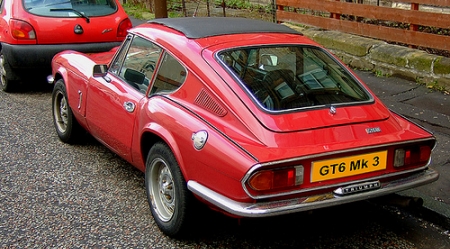 Mk3 in 1970 got a stylish
facelift but little mechanical mods. However, the GT6 was not as
popular as British Leyland hoped for. It survived for only 7 years.
|